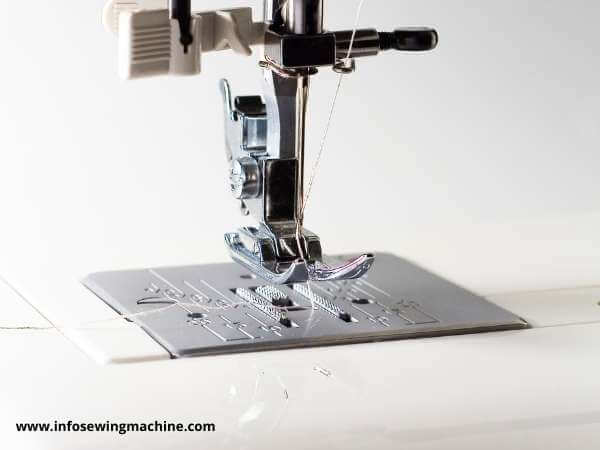Sewing Machine Needles Explained – An Ultimate Guide
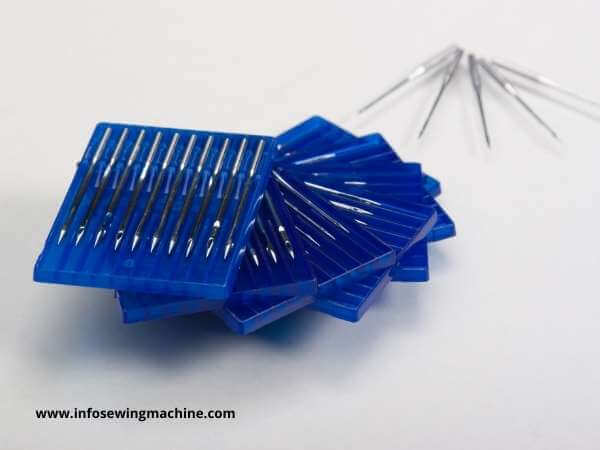
An Overview – Sewing Machine Needles Explained
We’re talking about Sewing Machine Needles here. But that is only part of it. Let’s dig a little deeper. The sewing needle is the most important piece of equipment used by sewers. It can easily be overlooked or missed.
Needle selection is the single most important step when creating a quality garment. Most sewing enthusiasts will agree that choosing the correct Needle can make the difference between success and failure when sewing a garment. However, selecting the correct type of Needle can be confusing, particularly for beginners.
This article will provide a step-by-step overview of the best practices for selecting a size of needles, all types of Needles For Sewing Machines, and some tips for maximizing needle life. After reading this article, we hope you can select the proper Sewing Machine Needles and where to use them based on the fabric thickness, etc.
What Is A Sewing Machine Needle?
A Sewing Machine Needle is a very important part of a sewing machine that makes the fabric thread through the cloth. A sewing machine needle is a thin, sharp-pointed tool that fits into a small hole in the plate to allow the thread to be pulled through and make a stitch in the Fabric.
With a sewing machine needle, you sew through layers of Fabric using a sharp instrument to stitch pieces of fabric together. This tool helps maintain proper sewing threads, ensuring the stitches remain strong and stable. Some sewing machines feature additional sewing needles that are used for decorative purposes.
Parts Of A Sewing Machine Needles
To read about sewing machines, first, we will discuss the parts of the sewing machine needle. When you look at a Sewing Machine Needle, it looks like a simple straight needle with an eye in the end, but it has some names for its parts.
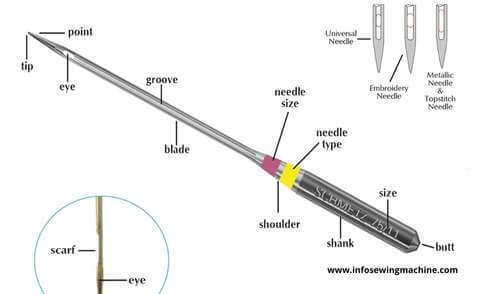
Shank Of A Sewing Machine Needle
The fat, top part of the sewing machine needle is called the Shank. Household Sewing Machine Needles are flat on the back and round from the front side. This feature provides security that the Needle is properly inserted.
Shaft Of A Sewing Machine Needle
There is a Shaft below the top of the Needle. It is the round part from which the thread travels down through the eye.
Groove Or Scarf Of A Sewing Machine Needle
A groove or scarf is the part of the Needle above the eye of the Needle. It allows the Needle to pick the thread to form the stitch. The scarf is best for less fraying and breakage of Sewing Machine Thread.
Eye Of A Sewing Machine Needle
An important part of the sewing machine needle is used to thread the Needle. Some needles have wider eyes, and some come with smaller eyes. This depends on the usage of Needle and Fabric sewn.
Needle Point Of A Sewing Machine
The needlepoint is the tip of the Needle that goes through the Fabric to stitch. Sewing Machine Needles come with different needle points according to their user type.
01. Ballpoint
Ball Point Needles have rounded tips that allow the Needle to push the knitted fabrics to either side. These needles are good for knitted fabrics to sew without piercing through them.
02. Setpoint
Set Point Needles are used to sew Woven Fabrics. These needles are sharper than the Ball Point Needles.
03. Wedge Or Cutting point
These Needles are excellent for sewing dense material like leather. These needles can cut directly through the material for easy stitching.
Size Of Sewing Machine Needles
Sewing Machines sizes are available in different both American and European Sizes. The sizes depend on the thickness of the Shaft.
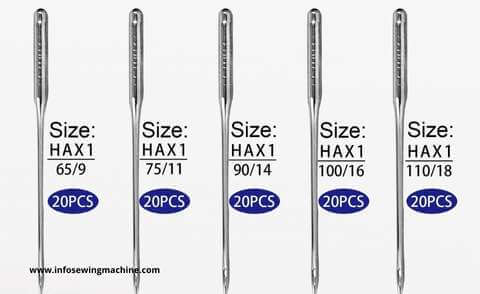
- Remember, the smaller the Number written on the Needle, the Finer the Needle is. This kind of Needle can accommodate the Finer type of thread. As well as the larger the number is written on the Needle, the thicker the Needle is. This kind of Needle can accommodate Thick types of threads.
- The size of the sewing machine is written in the form of A/B. Where A and B belong to American Size and European Size. The range of the American Number is between 8 to 20. and the Range of European numbers is between 60 to 120. For Example, you can find needles with the sizes 70/10 or 100/16, etc
- For more clarification, remember A 120 needle is 1.1 mm in diameter, a 110 needle is 1.1 mm in diameter, and a 90 needle is 0.9 mm in diameter.
Rule For Choosing A Sewing Machine Needle
The basic rule for choosing the correct size of Needle is to consider the type, thread weight, and Fabric weight. Choosing the wrong Needle may cause Thread Breaking, Needle Breaking, Skipped Stitches, or Bobbin Jamming.
01. Needle Size According To Type And Weight Of The Thread
The type and weight of the thread are also considered before choosing the right kind of Needle.
As we discussed in the article, the Larger size of needles can accommodate thicker threads, and smaller size of needles can accommodate finer threads. If you do not choose the right kind of Needle, then there are two possibilities. The first larger Needle leave holes in the Fabric, which is not sewed tightly. Second, using a thick thread with fine needles can cause Thread Breaking, Skipped Stitches, and Needle Breaking.
Feeding the thick thread through the Needle’s eye is also difficult.
02. Needle Size According To Weight Of Fabric
Consider the weight of the fabric to be sewn before choosing the needle size because many types of needles are available for different kinds of fabrics. We will discuss the different kinds of needles next in this article.
A lightweight fabric needs a very fine needle, and a heavyweight fabric can be sewn well with a thick needle. You can determine the weight of fabric by its thickness or thread density, or composition.
Types Of Sewing Machine Needles
To begin with, there are two main categories of sewing machine needles: General Purpose Needles and Specialty Needles. General purpose sewing machine needles are usually made of chrome steel and have a diameter of 0.5 mm to 1.5 mm. They can easily take any thread that has a size suitable for the machine used and are most widely used because of their low price.
Specialty Sewing Machine Needles are more expensive than general purpose needles but offer many options for the sewist, such as different tip shapes, thread capacities, eye preferences, and needle sizes.
General Purpose Needles
01. Universal Needles
Universal needles are very useful—because they work with all Sewing Machines, even if the brand and model aren’t specified. You should use a specialized sewing machine needle if you have a specific machine you don’t want to be compatible with. Universal needles are perfect for beginners because they are relatively easy to use but are also easy to interchange between different brands and models.
02. Selfthreaded Or Handicap Needles
These needles are very good to deal with. These needles come with a large, open slot, making threading them easy. So these needles are also comfortable for people who find it difficult to thread a needle. These needles are relatively similar to Universal Needles.
03. Stretch Needles
Stretch needles are an improved version of ballpoint needles and do not damage fabric that is stretchable. Stretch needles have a slightly curved point that allows them to easily glide through the fabric without causing damage. They are typically slightly wider in diameter than standard needles, making them easier to handle.
When you sew, the stretch needle will slide through the fabric and be held by the sewing machine. This works best with sewing machines that have an “automatic” or “touch-up” button. Once the needle is threaded, you can sew as usual. The thread will be caught by the stretch needle when the machine sews.
04. Denim Or Jeans Needles
The best type of needle for denim and canvas is a strong needle with a long point. These needles are very strong with a sharp point. These needles can sew tightly woven and heavy fabrics like Denim, Jeans, and Canvas. These needles are strong enough that they can not easily breakable and do not bend during the sewing process.
05. Leather Needles
Leather needles are best to work with leather. These needles do not damage the leather and do not cause Skipped Stitches. These are wedge-shaped like an arrowhead. If you sew leather with a normal needle it causes leather to gather at a place and damage it. But these needles can not be used on knitted or woven fabrics.
06. Embroidery Needles
Embroidery needles come in a variety of sizes, but all of them have the same basic features: a point that is medium sharp, an oversized eye, and a groove to protect delicate threads. These needles can be used for embroidery threads like Polyester, Rayon, and Cotton.
07. Ballpoint Needles
This is a very basic sewing machine needle. It is not recommended for use with heavy fabrics like denim or leather. It is perfect for lighter-weight fabrics like cotton, linen, and silks. It is also a great choice for quilting, embroidery, knitting, and other crafts. This is the type of needle that is most often found in a household sewing machine.
08. Metallic Needles
Metallic needles are designed with elongated eyes to allow them to glide through the fabric with minimal friction, preventing thread breakage. These needles can be used with other embroidery threads as well. Its large eye allows it smoothly thread freely.
09. Jersey Needles
Jersey Needles are best to use with jersey stuff which has elasticity. The needle easily passes through the fabric and thus the thread to attach the top and bottom of fabrics together. These needles allow fabric to sew comfortably without gathering under the presser feet.
10. Topstitch Needles
Topstitch needles come with sharp points, large eyes and enlarged groove to accommodate decorative or thick threads. It can stitch multiple layers.
They can be used for both hand and machine topstitching. Topstitch Nedles are often used in quilting for creating the decorative edge of quilts or in other stitching that requires thick thread. Topstitch Needles Topstitch needles are available in a variety of sizes and types. The most common size is a 1/32-inch (0.19 mm) size, which is suitable for machine topstitching quilts. It has a large eye and a sharp point.
11. Twin And Triple Stith Needle
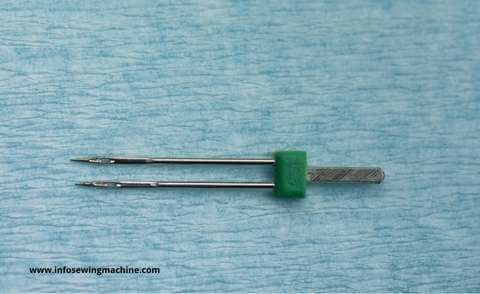
The twin and triple stitch needle is a needle used to sew thread through thick fabric. This type of needle is a combination of regular double needles and a single needle. This needle has two needles joined together, but only one is attached to the handle. The handle is shorter than usual, but the tip is longer. It can be used to sew thicker materials.
12. Microtex Or Sharp Needles
Microtex sewing needles are made from steel coated with a protective layer of a synthetic material called nylon. Synthetic material such as nylon is more durable than metal because nylon has a higher resistance to heat and friction. These needles, which are commonly used by professionals, are also ideal for embroidery and quilting.
13. Quilting Needles
Quilting needles are made in a special way to make sewing a breeze. Their tapered design penetrates multiple layers of fabric, even in areas where multiple seams intersect, and is easy to use. The quilting needles have a thin, sharp point on one end and a thicker, blunt end on the other. This design makes it easy to penetrate multiple layers of fabric without breaking the thread.
14. Wing Needles
Wing needles have a wide blade, or wing, on each side of the needle. This needle cuts a decorative groove in the fabric every time the needle is passed through. This type of needle is used for knitting or crocheting in the round. The cable needle is a type of needle with a large eye that can hold a large amount of yarn. It is used to move the yarn in a specific direction without having to keep switching between different needles.
Specialty Needles
These needles can accomplish certain tasks for better sewing.
Ball Point (Style 2045)
These needles have round tips specially used for sewing on knits. It smoothly passes between the threads of knitted fabric, by separating them.
Universal (Style 2020)
These are straight-pointed sewing needles. It’s perfect for weaving fabrics. These are used for woven fabrics of all types.
Chromium Regular Point (Style 2000)
These needles have the ability to tolerate the speed of embroidery machines and are recommended to sew woven fabrics with the Quantum and Singer Embroidery Machines. These needles are strong and thus long-lasting.
Chromium Ball Point (Style 2001)
These needles can tolerate the speed of embroidery machines and are recommended to sew knitted fabrics with the Quantum and Singer Embroidery Machines. These needles are strong and thus long-lasting.
Denim or Jeans (Style 2026)
Recommended to deal with jeans, denim, and canvas. These needles can sew heavy and tough fabrics.
Leather (Style 2032)
Recommended to deal with leather without causing any damage. These are also used to sew vinyl.
Twin Needle (Style 2025)
The needles are used for machine stitches closely-spaced parallel rows, then stitches another closely-spaced parallel row for decorative stitching.
Hemstitch or Wing Needle (Style 2040)
These needles are used in heirloom sewing to create tiny holes in the fabric while sewing. Best to deal with fabric like cotton and linen.
Are All Sewing Machine Needles Universal?
No, Sewing Machine Needles are not universal as you read all the types of sewing machine needles and know better about the difference between all the kinds. There are some Universal needles, but they are not suitable for every kind of sewing. You can read the details here: Are Sewing Machine Needles Universal?
Can Sewing Machine Needles Break?
Yes, Sewing Machine Needles are breakable, and occasionally they can break because of problems like wrong tension, thread size, needle size, and many more. You can read the details here: Why Do Sewing Machine Needles Break?
When It Is Time To Change The Machine Sewing Needles?
- If you are using a new thread type or fabric, you must change the needle compatibility to work with them.
- If the needle is damaged, dull, or bent, it’s time to change it.
- If you are using a needle for a long time, like more than 6 to 8 months. then it is recommended to change the needle. There is no need to use a needle to sew repeatedly. Normally replace the needle after 10 to 12 hours of stitching.
Conclusion | Sewing Machine Needles Explained
In conclusion, sewing needles are small tools used to sew fabric and other items. They consist of a pointed tip attached to a blunt end. Each needle type has a different purpose. Some needles are straight, while others have grooves or ridges. Some are designed to hold a stitch, while others have hook shapes that allow them to grab the thread and pull it through. In this article, we tried to cover all Sewing Machine Needle Types. We also explained how to keep sewing needles from breaking or bending over time.
We hope this Sewing Machine Needles Guide will help you understand all about Needles.
FAQs | Sewing Machine Needles Explained
Do I need different sewing needles for different fabrics?
Yes, you do. It would be best if you had different sewing needles for different fabrics. The fabric you’re sewing determines which type of needle you should use.
Why do I need to change my sewing machine needles?
Sewing machine needles get dull from use. So, replacing them at least after 10 to 12 hours of stitching is better.
What’s the best way to keep sewing machine needles from getting bent?
The best way to keep sewing machine needles from getting bent is to use a Needle Guard For Sewing machines.
What is the difference between a regular sewing machine needle and an embroidery needle?
The main difference between a regular sewing machine needle and an embroidery needle is that embroidery needles have a much finer point. They are designed for embroidery and are not meant to be used on a regular sewing machine.


